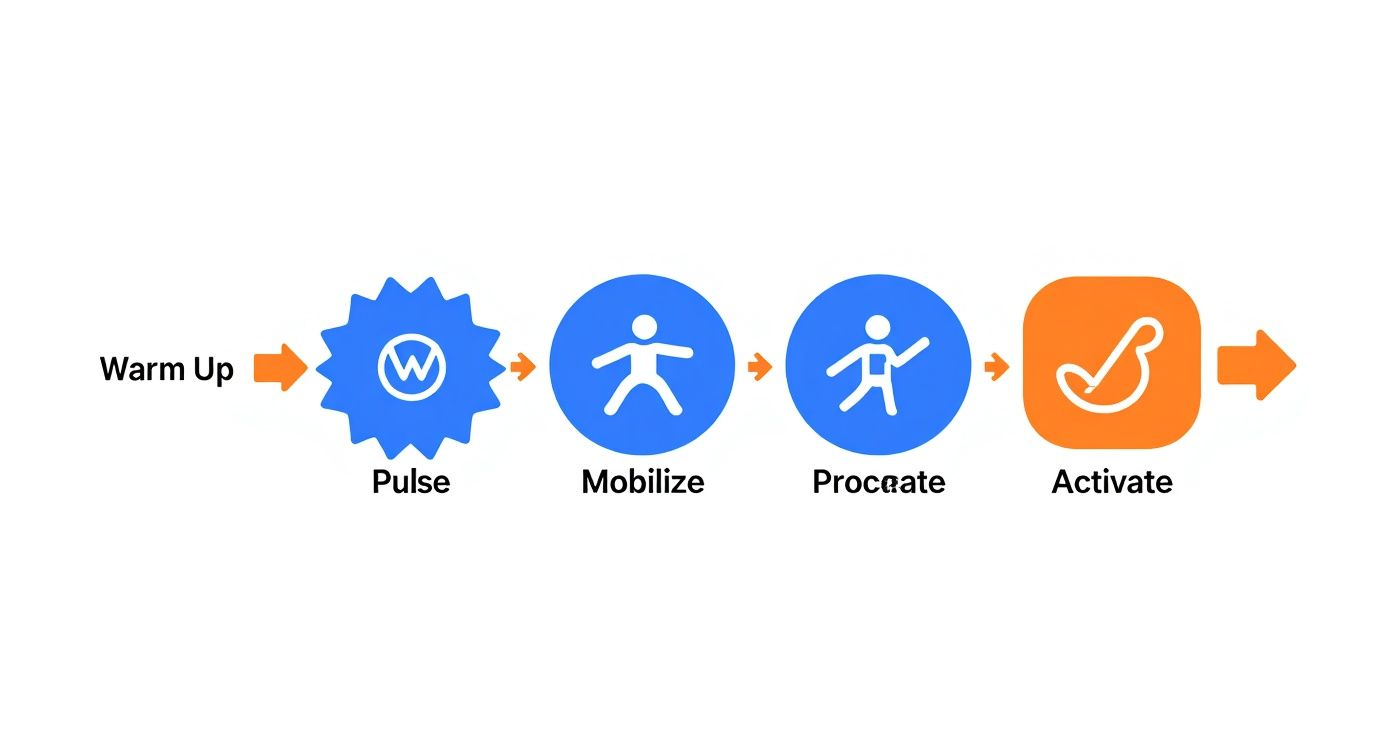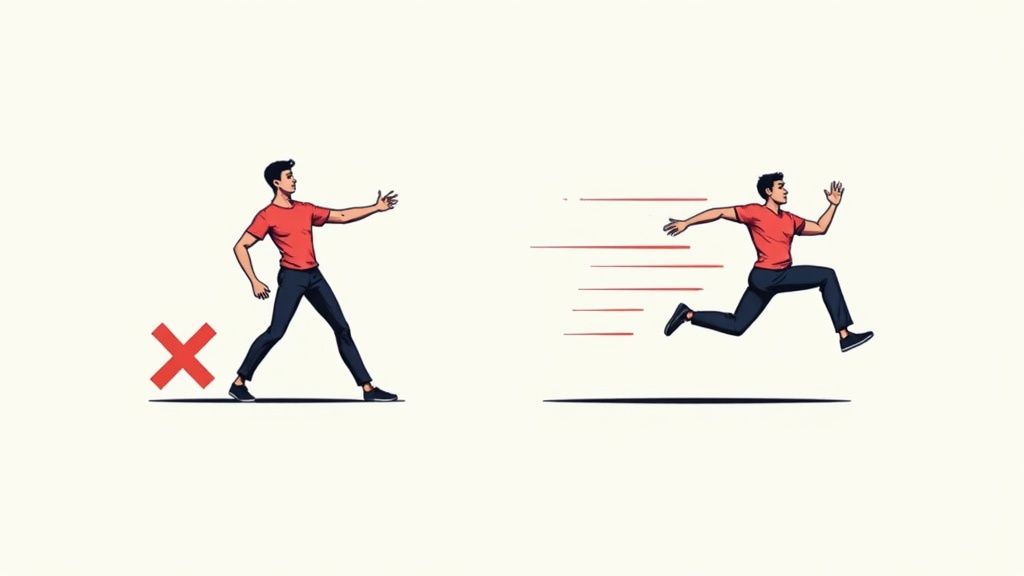Ever been so eager to start your workout that you just jump right in? We've all been there. But skipping those first few minutes is one of the biggest mistakes you can make. A proper warm-up isn't just a "nice-to-have"—it's the secret to a better, safer, and more effective workout, especially when you're training at home.
So, what does a great warm-up look like? Forget long, boring stretches. All you need is 5-10 minutes of simple, dynamic movements to get your body ready for action. This guide will show you exactly how to warm up before a workout using our simple, equipment-free method.
What You'll Need
- Yourself
- A small amount of floor space
- An optional yoga mat for comfort
Why a Proper Warm-Up Is Not Optional
Let's be real—when you're short on time, the warm-up is often the first thing to go. But what if we told you those first few minutes are the most important part of your entire session? Skipping your warm-up is like asking your body to go from zero to sixty without any warning. It’s a surefire way to hurt your performance and open the door to injuries.
Think of your muscles as rubber bands. If they've been sitting cold all day, yanking on them suddenly can easily lead to strains. A good warm-up gently increases your body temperature and gets your blood flowing, delivering that much-needed oxygen to your muscles. This makes them more flexible and ready for action.
More Than Just Injury Prevention
Sure, avoiding pulls and strains is a huge benefit, but the perks of a proper warm-up run much deeper. It’s really about setting the stage for a fantastic workout.
Here’s a quick look at what’s happening in your body:
- Your joints get lubricated. Movement stimulates the production of synovial fluid, which is basically oil for your joints. This helps everything move more smoothly and with less friction.
- Your mind-muscle connection kicks in. A warm-up wakes up your nervous system, improving the communication lines between your brain and the specific muscles you're about to use.
- Your performance gets a boost. When your muscles are properly primed, they can contract more forcefully and efficiently. That means you can push a little harder and get more out of every single rep.
The goal isn’t just to avoid getting hurt today; it’s to build a sustainable fitness habit that keeps you moving consistently for years. Making a warm-up a non-negotiable part of your routine is the secret to long-term success.
While we often think a warm-up prevents injury in that single session, research suggests it’s the consistent, long-term habit of warming up that truly makes a difference. It’s a vital practice for raising your body temperature, getting your nervous system ready, and mentally preparing for any physical activity. For a deeper dive, you can explore the scientific perspective on warm-up practices and injury prevention.
The 3-Part Bare Fitness Warm-Up
Warming up doesn't need to be complicated. Forget overthinking it. You just need a simple, repeatable system that actually prepares your body for the work ahead.
At Bare Fitness, we've stripped it down to the essentials with our Pulse, Mobilize, Activate method. It's a straightforward framework that gets rid of the guesswork and ensures you're properly prepped in just a few minutes, every single time.
The 3 Pillars of an Effective Warm-Up
Think of these phases as building on each other. Each one logically sets you up for the next, seamlessly taking your body from a resting state to being ready for action.
This simple sequence ensures you hit all the key components of a solid warm-up without wasting any time.
Pulse: Get the Blood Pumping
First, you need to get your blood moving. The goal here is to gently raise your body's core temperature. Just a few minutes of light cardio is enough to get your heart rate up, sending warm, oxygen-rich blood to the muscles you're about to put to work.
Mobilize: Unlock Your Joints
With your body warmer, it's time to focus on your joints. This phase is all about dynamic movements—not holding static stretches. You'll take your joints through their full, healthy range of motion. Think of it as lubricating your hips, shoulders, and spine so you can move smoothly and correctly during your main lifts.
Activate: Fire Up the Right Muscles
The final step is to wake up the exact muscles you plan on training. This step reinforces your mind-muscle connection, making sure the right muscles are firing properly from your very first rep. It’s the difference between a sloppy set and a strong, effective one.
This 'Pulse, Mobilize, Activate' sequence is your go-to blueprint. It's not a rigid set of rules but a flexible framework you can tailor to any workout, ensuring you’re primed for action without needing any fancy equipment. It's the bare essential for staying injury-free and getting more out of every session.
Your Go-To 10-Minute Warm-Up Routine
Ready to put the Pulse, Mobilize, and Activate method into practice? Here is a complete 10-minute routine that requires zero equipment, making it perfect for any workout you're tackling at home. Follow along before every session.

We're going to move through each exercise for a set amount of time. The key here is to focus on smooth, controlled movements. Don't rush it. Remember, the goal is preparation, not exhaustion.
Phase 1: Pulse (Minutes 0-3)
Let's get your heart pumping and gently raise your body temperature. This initial phase sends warm, oxygenated blood to your muscles, waking them up for the work ahead.
- Form Cue: Land softly on the balls of your feet.
- Form Cue: Keep your core engaged and your back straight.
- Form Cue: Avoid arching your lower back.
Phase 2: Mobilize (Minutes 3-7)
Alright, you're warm. Now it's time for dynamic stretches. These are active movements designed to take your joints through their full range of motion.
- Form Cue: Keep your shoulders relaxed, away from your ears.
- Form Cue: Keep your upper body still and let the leg swing like a pendulum.
- Form Cue: Sync your breath with the movement—inhale into Cow, exhale into Cat.
- Form Cue: Try to keep your back leg straight and engaged.
- Form Cue: Drive through your heels to stand back up.
- Form Cue: Avoid over-arching your back; stop when your body forms a straight line from knees to shoulders.
- Form Cue: Keep your core tight to prevent your hips from sagging in the plank position.
- Progression: Try single-leg glute bridges to activate each side independently.
- Modification: If you don't have a band, perform "no-money" exercises by squeezing your shoulder blades together with arms bent at 90 degrees.
- Progression: Add a push-up at the bottom of your inchworm for an extra challenge.
- Going Too Hard, Too Soon: Your warm-up should build intensity gradually. Jumping straight into explosive movements can shock your system instead of priming it.
- Rushing Through the Movements: Just flailing your arms and legs around won't activate the right muscles. Each movement should be controlled and deliberate to build that mind-muscle connection.
- For a quick calorie burn: Jump into a simple HIIT session. A classic is 30 seconds of Bodyweight Squats, followed by 30 seconds of rest. Repeat for 8 rounds.
- To build strength: A bodyweight circuit is your best bet. Try three rounds of Push-Ups, Lunges, and Glute Bridges, focusing on solid form.
- To focus on mobility: This is the perfect time to flow into a longer mobility session. Your joints are already warm, so you can work on deeper ranges of motion more safely.
- 1 minute of jogging in place
- 1 minute of bodyweight squats
- 1 minute of arm circles and leg swings
Phase 3: Activate (Minutes 7-10)
For the final step, we need to wake up the specific muscles you're about to use. This sharpens that mind-muscle connection.
This simple 10-minute sequence is your blueprint for a solid warm-up. It's a reliable system that shows you exactly how to warm up before a workout, setting you up for a great session, every single time.
How to Customize Your Warm Up for Any Workout
Our 10-minute routine is a fantastic all-purpose starting point, but the best warm-up is the one built for the workout you're about to do.
Think of it as a dress rehearsal for your main session. The goal is to prime the exact muscles you're about to challenge. This is where you can take our "Activate" phase to the next level. This isn't just theory; it's backed by science. For a deeper dive, check out how warming up impacts your workout.
Tailoring Your 'Activate' Phase
After you've gone through your general "Pulse" and "Mobilize" work, the last few minutes are where you can get specific with movements that mimic what’s on your workout plan.
Here’s how that looks in practice:
By simply tweaking the final three minutes of your warm-up to match your workout, you're not just preventing injury—you're actively improving your performance from the very first set. It’s a small change that delivers big results.
Common Warm-Up Mistakes to Avoid

Knowing how to warm up before a workout is one thing, but knowing what not to do is just as important. It’s easy to turn a good intention into a counterproductive habit.
The biggest mistake is holding long, deep static stretches before a workout. We all know the classic "touch your toes and hold for 30 seconds." While great for flexibility after you exercise, doing this on cold muscles can actually reduce your power output.
Another common error is skipping the warm-up entirely. You might be surprised how common this is. A study on amateur golfers found that over 70% rarely or never warmed up. You can read more about these findings on warm-up habits to see just how prevalent this mindset is.
Keeping Your Warm-Up in Check
Remember, the goal is preparation, not exhaustion. Think of your warm-up as the bridge to your workout, not a mini-workout itself.
Here are a few more things to watch for:
The most effective warm-up is intentional. It’s not about just going through the motions; it's about purposefully preparing your body and mind for the specific demands of the workout ahead. Avoid these common mistakes, and you'll get far more out of every minute.
Next Steps: What to Do After Your Warm-Up
Alright, you've finished the warm-up, you're feeling loose, and your body is ready for action. What now? The key is to start your main workout within a minute or two of finishing your last warm-up move.
This isn't the time to check your phone or get sidetracked. You want to capitalize on that increased blood flow and muscle activation you just worked for. Go straight into your planned routine to make the most of it.
Your Next Bare Fitness Move
One of the best things about this warm-up is that it gets you ready for just about any kind of equipment-free workout.
Here are a few ways you can immediately put that prep to good use:
Your Warm-Up Questions, Answered
Warming up can feel like a gray area, so let's clear up some common questions.
How long should a warm-up really take?
Aim for 5 to 15 minutes. For the equipment-free workouts we focus on at Bare Fitness, that 5-10 minute window is the sweet spot. If you're gearing up for a really tough workout or just woke up feeling extra stiff, extending that to 15 minutes is a smart move. You should feel loose and ready, not tired.
Is static stretching before a workout ever a good idea?
As a rule, save those long "hold-it-right-there" stretches for your cool-down. Research shows they can decrease muscle power right before you need it most. However, if a specific muscle—like a tight hip flexor—is so stiff it's messing with your form, it's okay to hold a very brief stretch (15-20 seconds max) on just that spot after your dynamic warm-up. Dynamic movement should always be the star of the show.
A short warm-up is always better than no warm-up at all. Consistency over perfection is key to staying injury-free and making progress.
What if I'm seriously strapped for time?
Life happens. If you only have 20 minutes total, don't skip the prep. A super-condensed, 3-minute warm-up is way better than nothing. Focus on a few movements that mirror what you're about to do. For a quick bodyweight circuit, you could do:
Ready to put this all into practice? The team at Bare Fitness is all about follow-along routines and no-nonsense fitness advice made for real, busy people. Check out more of our guides and workouts to build a routine that actually sticks. Find your next workout with Bare Fitness.




















